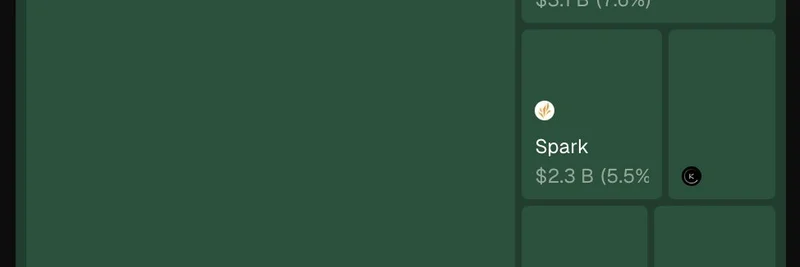If you've been diving into the world of decentralized finance (DeFi), you've probably noticed how a handful of players seem to hog the spotlight. That's the power law in action—a principle where a small number of entities capture the lion's share of the market. Recently, Token Terminal shared a striking visualization on X that perfectly illustrates this in the lending sector.
The chart breaks down active loans over the past 24 hours among top lending protocols. Aave, the heavyweight in DeFi lending, commands a whopping $27.1 billion, making up 65.8% of the total. For those new to the term, active loans refer to the outstanding borrowed amounts that users have taken out using these platforms, often collateralized by crypto assets like ETH or stablecoins.
Trailing behind is Morpho, with $3.1 billion (7.6%), a protocol that's gaining traction for its optimized lending rates and risk management features. Then there's Spark, clocking in at $2.3 billion (5.5%), which focuses on efficient capital utilization in the Ethereum ecosystem. Smaller players like Compound, Venus, and others fill out the rest, but their slices are tiny in comparison—highlighting that classic power law distribution where the top few dominate.
Why Does This Matter for Meme Token Enthusiasts?
You might be wondering, "I'm here for meme tokens—how does DeFi lending fit in?" Well, meme tokens often thrive on liquidity and leverage. Platforms like Aave allow users to borrow against their holdings to ape into the next big meme coin pump. Understanding where the lending action is concentrated can help you gauge market sentiment and liquidity flows. For instance, if borrowing spikes on Aave, it could signal increased speculation in volatile assets, including memes.
Plus, as blockchain practitioners, keeping tabs on these metrics sharpens your edge. Token Terminal's data underscores how consolidated the lending space is, which could influence everything from yield farming strategies to risk assessment when using these protocols for meme-related trades.
Breaking Down the Power Law in Crypto
The power law, sometimes called the 80/20 rule or Pareto principle, isn't unique to crypto—it's everywhere from wealth distribution to social media followers. In DeFi, it means a few protocols like Aave attract most users and capital due to network effects, better security track records, and user-friendly interfaces. Aave's dominance isn't surprising; it's been around since 2017 (originally as ETHLend) and has evolved into a multi-chain behemoth supporting assets across Ethereum, Polygon, and more.
Morpho and Spark are challengers worth watching. Morpho, for example, uses a peer-to-peer model to offer better rates than traditional pools, potentially eating into Aave's share over time. Spark, backed by MakerDAO, emphasizes DAI-centric lending, which ties into stablecoin ecosystems that meme traders often use for hedging.
Key Takeaways from the Data
- Aave's Lead: With over 65% market share, it's the go-to for reliable borrowing and lending. If you're holding meme tokens, consider using Aave for collateralized loans to avoid selling during dips.
- Emerging Competitors: Morpho and Spark together hold about 13%, showing room for innovation. Keep an eye on their growth, especially if they integrate more meme-friendly features.
- Market Implications: This concentration could mean higher risks if Aave faces issues, but it also ensures deep liquidity for users.
In the fast-paced crypto world, visuals like this from Token Terminal are gold for spotting trends. If you're building your knowledge base on meme tokens and broader blockchain tech, data points like these help connect the dots between DeFi infrastructure and speculative plays.
Stay tuned to Meme Insider for more breakdowns on how DeFi intersects with the meme economy. What's your take on Aave's dominance—bullish or a sign of centralization creeping into DeFi? Drop your thoughts below!



